Net Zero Buildings—A Framework for an Integrated Policy in Chile
Abstract
1. Introduction
2. Methodology
2.1. Literature Review
- (1)
- AChEE (Chilean Energy Efficiency Agency)
- (2)
- MOE (Ministry of Energy in Chile)
- (3)
- MOP EE (Eficiencia Energetica) Ministry of Public Works
- (4)
- Passivhaus Chile
2.2. Framework Development
2.3. Focus Group Discussions
- (1)
- Technological Approach
- (2)
- Energy Efficiency and Primary Energy Requirements
- (3)
- Comfort Requirements
- (4)
- Renewables Share
- (5)
- Construction Quality
3. Results
3.1. NZEB Defintions
3.2. NZEB Principles
- (1)
- Reduce the energy demand for all newly constructed buildings. The energy demand value is for the sum of the demands of buildings, space heating, space cooling, DHW, auxiliary energy, ventilation, lighting, and appliances [1].
- (2)
- Improve IEQ, allowing for maximum thermal comfort and avoidance of overheating. This includes air quality control through mechanical ventilation [1].
- (3)
- Fix a percentage of renewable energy demand to be covered by renewable energy annual balance.
- (4)
- Reduce the overarching value for primary energy consumption and carbon emissions per year. It is also important to amend additional measures to address mobility and materials’ embodied energy issues [1].
3.3. A Framework for a New Standard for Chile
- is the primary energy indicator (kWh/m2.a);
- is the net used floor area (m2) calculated according to national definition;
- is the non-renewable primary energy (kWh/a);
- is the delivered energy on site (kWh/a) for energy carrier i;
- is the non-renewable primary energy factor for the delivered energy carrier i;
- is the exported energy on site (kWh/a) for energy carrier i;
- is the non-renewable primary energy factor for the delivered energy compensated by the exported energy for energy carrier i; which is equal to the factor of the delivered energy, if not defined nationally in different way.
- is the CO2 emission indicator (kgCO2/m2.a);
- is CO2 emission (kgCO2/a);
- is the net used floor area (m2) calculated according to national definition;
- is the delivered energy on site (kWh/a) for energy carrier i;
- is the CO2 emission coefficient (kgCO2/kWh) for the delivered energy carrier i;
- is the exported energy on site (kWh/a) for energy carrier i;
- is the CO2 emission coefficient (kgCO2/kWh) for the exported energy carrier I, depending on national definition.
3.4. Focus Group Discussions
- (1)
- The absence of environmental taxation systems for fossil energy and energy pricing policy, results in economic subsidies for investments in buildings energy efficiency.
- (2)
- NZEB green technologies investment costs are viewed as excessively high particularly in relation the high real estate cost and low wages in Chile. A fact that stand as a barrier in the proliferation of NZEB [34].
- (3)
- The lack of institutional infrastructure to enforce the compliance with the TDRe and building certification and the absence of penalties for code violation.
- (4)
- The current building code (TDRe) is outdated and need to align with the NZEB approach.
- (5)
- There is a lack of professional qualification and vocational education and technical staff ready to handle NZEB solutions and technologies.
- (6)
- Public awareness of the end-users on the importance of healthy and climate neural buildings is limited.
- (7)
- There is an underdeveloped market and absence of an industrial infrastructure to carry on an ecosystems’ of NZEB components and materials producers and suppliers. The Chilean market is open to imports without protection and investments in local made energy efficiency technologies.
4. Discussion
4.1. Summary of Main Findings
- (1)
- The identification of context-specific comfort requirements for all building types to allow setting the performance thresholds for NZEB. Comfort definition and fuel poverty are an important challenge in Chile [33] that need to be addressed first.
- (2)
- Developing and adopting a low-tech alternative of the Passive House Standard is a crucial approach to define a low-tech NZEB. There is a need to develop new building service technologies that are adapted to the socio-economic status and local energy market in Chile [1].
- (3)
- We developed and validated a set of performance indicators; metrics and performance threshold for a new NZEB standard in Chile (see Table 3).
- (4)
- Reduction of plug-loads and lighting can facilitate achieving NZEB. The need for building decarbonization will bring electrification to Chile. Therefore, any new standard should address electric loads and suggest measurable consumption limits and foresee the grid flexibility [7].
- (5)
- We developed and validated a calculation method for the energy balance that should be included in the new NZEB standard in Chile (see Equations (1) and (2)).
4.2. Strengths and Limitations of the Study
4.3. Implications for Practice and Future Research
5. Conclusions
Author Contributions
Funding
Acknowledgments
Conflicts of Interest
Appendix A
| What technology to develop or transform for the implementation of Zero Energy buildings in Chile? Experts: Shady Attia | Andrés Montero | María Elena Soldatti Representative: Laura Marín Restrepo |
| There are technologies in Chile that can support the implementation of Zero Energy buildings, as well as the potential for the use of alternative energies and the technical knowledge for its development. Therefore, the implementation challenges are political and cultural, as well as it is essential to educate the end users of the buildings on issues of sustainability and efficiency. Before thinking about technologies or specific design, the city must be planned. Having a regulated and planned urban growth is necessary for energy efficiency and environmental comfort strategies can work. Likewise, it is important to optimize passive strategies first, since in some regions in Chile it is not necessary to invest heavily in technology so that a building consumes less energy and people are comfortable. It is also considered that culture is important within the space needs and comfort requirements, so it does not apply the same standard. The concern is generated, for example, how to conserve heat and/or heating without using mechanical ventilation? Is it possible? The Zero Energy standard points to greater isolation and necessarily involves mechanical ventilation, however, people in Chile, or at least Concepción, are not familiar with airtight and automated spaces. Can Chileans adapt to artificial environments? Is it necessary in this context? It reflects that a balance must be found between the perception of people and their requirements, with the mechanical systems that are implemented. The role of real estate and state regulation is fundamental since they usually point to interests that differ. There is pressure from real estate and the construction market to reduce energy efficiency requirements. The option of centralized heating systems, for example, should be stated initiatives, because the real estate market does not support it because it is not convenient for it. Remains the concern about how communities would use these systems in a society such as Chile. On the other hand, mandatory certification is necessary for effective communication with users. If the buildings declare their performance and the users are informed, they will know what decisions to make and could demand efficient buildings. Similarly, given that there is a gap between the design/technologies and the construction and operation of the buildings, it is necessary to invest in skilled labor and in trained users to make an actual implementation. Regarding users, strategies should be sought to change the mentality of making decisions based on immediate impacts by decisions based on performance and long-term, to make investments. For this, the technology must be durable, because, in that way, the users know that the investment is worth it. Likewise, buildings must be functional, fulfil their basic purpose and be simple, so that people accept and demand Zero Energy buildings. Technologies do not need to be high range, they can be simple, and they are already in the market. Simple home automation, for example, can be used to support efficient use. Finally, regarding the heating requirement, which is the one that demands the most energy in the southern of Chile, it is believed that a change of mentality in people must be pointed out, because, although there are more efficient and less polluting technologies, traditional heating is cheaper, and people do not want to change it. |
| What opportunities or restrictions has the application of the concept of Zero Energy Architecture in buildings retrofit in Chile? Experts: Luis Braganza | Geoffrey Van Moeseke Representative: Jeremy Piggot |
| Opportunities Cultural/economic
Urban
Environmental
Restrictions Cultural/economic
Governmental
Retrofitting with Zero Energy criteria in heritage buildings can become quite complicated due to the legal restrictions that exist regarding its modification, and the impact on the aspirations of the community. |
| What opportunities or restrictions has the application of the concept of Zero Energy Architecture in new constructions in Chile? Experts: Felipe Encinas | Javier del Rio Representative: Susan Agurto |
| It is agreed that in Chile is not feasible to implement the Net Zero standard, but what must be done from the scope of the policy is to define its own standard, feasible to implement and according to the Chilean context. The economic factor, investment and cost of the constructions prevent that a standard like the Net Zero can be implemented. It is necessary to differentiate the solutions considering the conditions of local comfort and not under wide parameters that do not differentiate the exigency according to the climate of each locality. It is necessary to implement economic incentives that motivate the private to invest in such constructions and at the same time create a system that regulates the value that the private will estimate in their projects since the objective would be that the costs for the users do not increase. The normative change is necessary and complementary to the energetic qualification and certification. Progress must be made in both aspects. It will be necessary, in addition, to carry out an important diffusion campaign to put in value the implementation of sustainable constructions, creating this awareness in the users. It is necessary to develop a clear roadmap: to update thermal regulation so that it is a requirement to the private; to consolidate the information in a clear plan and to be a legal instrument, as well as to make the population aware of the concepts of sustainability. |
| What challenges has the implementation of Zero Energy Architecture to achieve environmental comfort in buildings and reducing energy poverty in Chile? Experts: Cristina Engel Representative: Paulina Wegertseder |
| The measures to be implemented must respond to the context in which it is inserted. Perhaps it is easy to reach a Zero Energy standard, but is it enough to achieve it? Are there no other priority problems? Is it what people need? There are user habits that show that they are not prepared for certain strategies, for example, ventilation. A challenge is to be part of the design process to the user because they will realize its role. Involving the user is key for a correct use of the building and greater awareness. In general, independent of the building sector that seeks to improve, it is necessary to involve the user from two perspectives: 1. In the design process as a fundamental variable, as well in the construction stage; 2. Educate him for the stage of use of the building. On the other hand, it is not enough to reach a Zero Energy standard in a building if you do not consider other deficiencies that influence the user comfort. Energy efficiency must be integral, as a strategy or goal. |
| What actions should be taken to ensure that the community demands Zero Energy buildings in Chile? Experts: Beatriz Piderit | Jesús Pulido Representative: Matías Tapia |
| Detecting key stakeholders (individuals and institutions) across the whole society, influencing decision-making in the construction sector. Organizing activities that integrate these actors, communities and private and public institutions, with all intermediate levels needed to be carried out (broadcasting, meetings, conversations). Efforts should be made to include the private sector (real estate, industrial sector, etc.). Conducting informational workshops to communities, for example, neighborhood associations, social groups or parent centres, to address the issues of energy efficiency of buildings. Participation of parents in school communities can be used to make broadcasts. Consolidation report: Laura Marín Restrepo English version 1: 21 August 2017 |
References
- Attia, S. Net Zero Energy Buildings (NZEB): Concepts, Frameworks and Roadmap for Project Analysis and Implementation; Elsevier: Amsterdam, The Netherlands, 2018; ISBN 978-0128124611. [Google Scholar] [CrossRef]
- EU. Directive 2010/31/EU of the European Parliament and of the Council of 19 May 2010 on the energy performance of buildings (recast). Off. J. Eur. Union 2010, 13–35. [Google Scholar] [CrossRef]
- The Danish Ministry of Economic and Business Affairs Danish Enterprise and Construction. Danish Building Regulations; The Danish Ministry of Economic and Business Affairs Danish Enterprise and Construction: Copenhagen, Denmark, 2015; Volume 2015, pp. 10–12. [Google Scholar]
- Bruxelle-capitale, M. De la Region de. Moniteur Belge; Brussels, Belgium, 2010. Available online: http://www.ejustice.just.fgov.be/cgi_loi/change_lg.pl?language=nl&la=F&cn=2013050209&table_name=loi (accessed on 28 February 2019).
- D’Agostino, D.; Zangheri, P.; Cuniberti, B.; Paci, D.; Bertoldi, P. Synthesis Report on the National Plans for Nearly Zero Energy Buildings (NZEBs); Joint Research Center (JRC) Publications, 2016. Available online: https://ec.europa.eu/jrc/en/publication/eur-scientific-and-technical-research-reports/synthesis-report-national-plans-nearly-zero-energy-buildings-nzebs-progress-member-states (accessed on 28 February 2019). [CrossRef]
- Attia, S.; Building Performance Institute Europe (BPIE). Nearly Zero Energy Buildings in Europe. Energy. 2015. Available online: http://bpie.eu/uploads/lib/document/attachment/128/BPIE_factsheet_nZEB_definitions_across_Europe.pdf (accessed on 6 March 2019).
- Attia, S.; Eleftheriou, P.; Xeni, F.; Morlot, R.; Ménézo, C.; Kostopoulos, V.; Betsi, M.; Kalaitzoglou, I.; Pagliano, L.; Cellura, M.; et al. Overview and future challenges of nearly Zero Energy Buildings (nZEB) design in Southern Europe. Energy Build. 2017, 155, 439–458. [Google Scholar] [CrossRef]
- Silva, S.M.; Almeida, M.G.; Bragança, L.; Carvalho, M. nZEB Training Needs in the Southern EU Countries—SouthZEB project. In Latin-American and European Encounter on Sustainable Building and Communities—Connecting People and Ideas; MULTICOMP-Artes Gráficas Lda: Algueirão–Mem Martins, Portugal, 2015; Volume 3, pp. 2469–2478. ISBN 978-989-96543-8-9. [Google Scholar]
- Muresan, A.A.; Attia, S. Energy efficiency in the Romanian residential building stock. Renew. Sustain. Energy Rev. 2017, 74, 349–363. [Google Scholar] [CrossRef]
- Vivanco, F. Towards an Integrated Policy for Net Zero Energy Schools in Chile: A Comparative Study with Belgium. Master’s Thesis, Department of Design Theory Architecture, University of Bío- Bío, Concepción, Chile, 2017. (In Spanish). [Google Scholar]
- EMC. Plan Nacional de Adaptación al Cambio Climático; Environmental Ministry of Chile, 2014. Available online: http://www.minambiente.gov.co/index.php/component/content/article/476-plantilla-cambio-climatico-%2032#documentos (accessed on 28 February 2019).
- MINVU. Terminos de Referencia Esta Estandarizados TDRe Confort Ambiental y Eficienca Energetica; Ministerio de Obras Publicas (MOP), Direccion de Aequitectura, Devision de Edification Publica, Unidad de Estandares y Efficiencia Energetica: Santiago, Chile, 2006. [Google Scholar]
- Schueftan, A.; Sommerhoff, J.; González, A.D. Firewood Demand and Energy Policy in South-Central Chile. Energy Sustain. Dev. 2016, 33, 26–35. [Google Scholar] [CrossRef]
- De Arquitectura, D. Términos de Referencia Estandarizados. Chile, 2016. Available online: http://arquitectura.mop.cl/centrodocumental/Documents/TDRe_MOP-DA_Parte3.pdf (accessed on 21 February 2019).
- Instituto de la Construcción. Manual Evaluación y Certificación. Certificación Edificio Sustentable, 2014. Available online: http://www.lebchile.cl/certificacion-edificio-sustentable/ (accessed on 28 February 2019).
- Carabaño, R.; Hernando, S.M.; Ruiz, D.; Bedoya, C. Life Cycle Assessment (LCA) of building materials for the evaluation of building sustainability: The case of thermal insulation materials. Rev. De La Construcción 2017, 16, 22–33. [Google Scholar] [CrossRef]
- Ministerio de Energía Chile. Energía 2050: Política Energética de Chile. 2015. Available online: http://www.energia2050.cl/es/energia-2050/energia-2050-politica-energetica-de-chile/ (accessed on 15 February 2019).
- Liţiu, A.V.; Buso, T.; Derjanecz, A.; Cuc, C.L.; Doboşi, I.S.; Retezan, A. Prof/trac project-improving skills for successfully designing, constructing, renovating and operating nearly zero energy buildings. Rev. Romana De Ing. Civ. 2018, 9, 301–306. [Google Scholar]
- QUALICHeCK. Overview of Existing Surveys on Energy Performance Related Quality and Compliance. 2015. Available online: http://qualicheck-platform.eu/2015/06/reportstatus-on-the-ground/ (accessed on 15 June 2018).
- Sierra-Pérez, J.; López-Forniés, I.; Boschmonart-Rives, J.; Gabarrell, X. Introducing eco-ideation and creativity techniques to increase and diversify the applications of eco-materials: The case of cork in the building sector. J. Clean. Prod. 2016, 137, 606–616. [Google Scholar] [CrossRef]
- Attia, S.; Bilir, S.; Safy, T.; Struck, C.; Loonen, R.; Goia, F. Current Trends and Future Challenges in the Performance Assessment of Adaptive Façade Systems. Energy Build. 2018, 179, 165–182. [Google Scholar] [CrossRef]
- Attia, S.; Piderit, B.; Van Moeseke, G. Resilience and Net-Zero Energy Buildings in Chile; SBD Lab.: Liège, Belgium, 2018; ISBN 978-2-930909-13-4. [Google Scholar]
- Marszal, A.J.; Heiselberg, P.; Bourrelle, J.S.; Musall, E.; Voss, K.; Sartori, I.; Napolitano, A. Zero Energy Building—A review of definitions and calculation methodologies. Energy Build. 2011, 43, 971–979. [Google Scholar] [CrossRef]
- Sartori, I.; Napolitano, A.; Marszal, A.J.; Pless, S.; Torcellini, P.; Voss, K. Criteria for Definition of Net Zero Energy Buildings. 2010. Available online: http://vbn.aau.dk/files/43736193/Criteria_for_Definition_of_Net_Zero_Energy_Buildings.pdf (accessed on 15 February 2018).
- Voss, K.; Sartori, I.; Napolitano, A.; Geier, S.; Gonzalves, H.; Hall, M.; Heiselberg, P.; Widén, J.; Candanedo, J.A.; Musall, E.; et al. Load Matching and Grid Interaction of Net Zero Energy Building. Proc. Build. Simul. 2011, 6, 14–16. [Google Scholar]
- Bourrelle, J.S.; Andresen, I.; Gustavsen, A. Energy payback: An attributional and environmentally focused approach to energy balance in net zero energy buildings. Energy Build. 2013, 65, 84–92. [Google Scholar] [CrossRef]
- Torcellini, P.; Pless, S.; Deru, M.; Crawley, D. Zero Energy Buildings: A Critical Look at the Definition. In Proceedings of the ACEEE Summer Study, Pacific Grove, CA, USA, 21–26 August 2006; p. 15. [Google Scholar] [CrossRef]
- Deng, S.; Wang, R.Z.; Dai, Y.J. How to evaluate performance of net zero energy building—A literature research. Energy 2014, 71, 1–16. [Google Scholar] [CrossRef]
- Kurnitski, J. Technical definition for nearly zero energy buildings—Active House Alliance. J. Fed. Eur. Heat. Vent. Air Cond. Assoc. 2013, 50, 22–28. [Google Scholar]
- Attia, S.; Carlucci, S. Impact of different thermal comfort models on zero energy residential buildings in hot climate. Energy Build. 2015, 102, 117–128. [Google Scholar] [CrossRef]
- Chan, W.R.; Sidheswaran, M.; Cohn, S.; Sullivan, D.P.; Fisk, W. Healthy Zero Energy Buildings (HZEB) Program—Cross-Sectional Study of Contaminant Levels, Source, Strengths, and Ventilation Rates in Retail Stores; Lawrence Berkeley National Lab. (LBNL): Berkeley, CA, USA, 2014. [Google Scholar]
- Boerstra, A. Towards HEAnZEBs! Rehva J. 2017, 5. Available online: https://www.rehva.eu/fileadmin/Publications_and_resources/REHVA_BRUSSELS_SUMMIT_2017_PPT/1145_Boerstra.pdf (accessed on 28 February 2019).
- Pérez-Fargallo, A.; Pulido-Arcas, J.A.; Rubio-Bellido, C.; Trebilcock, M.; Piderit, B.; Attia, S. Development of a new adaptive comfort model for low income housing in the central-south of Chile. Energy Build. 2018, 178, 94–106. [Google Scholar] [CrossRef]
- Yun, G.Y. Influences of perceived control on thermal comfort and energy use in buildings. Energy Build. 2018, 158, 822–830. [Google Scholar] [CrossRef]
- Kurnitski, J.; Allard, F.; Braham, D.; Goeders, G.; Heiselberg, P.; Jagemar, L.; Kosonen, R.; Lebrun, J.; Mazzarella, L.; Railio, J.; et al. How to define nearly net zero energy buildings nZEB. Rehva J. 2011, 48, 6–12. [Google Scholar]
- Active House. Active House Alliance. Available online: https://www.activehouse.info/ (accessed on 21 February 2019).
- Pacheco-Torgal, F.; Faria, J.; Jalali, S. Embodied energy versus operational energy. Showing the shortcomings of the energy performance building directive (EPBD). Materials Science Forum; Trans. Tech. Publications, 2013; Volume 730, pp. 587–591. Available online: https://www.scientific.net/MSF.730-732.587 (accessed on 15 June 2018).
- Sierra-Pérez, J.; Rodríguez-Soria, B.; Boschmonart-Rives, J.; Gabarrell, X. Integrated life cycle assessment and thermodynamic simulation of a public building’s envelope renovation: Conventional vs. Passivhaus proposal. Appl. Energy 2018, 212, 1510–1521. [Google Scholar] [CrossRef]
- Oh, J.; Hong, T.; Kim, H.; An, J.; Jeong, K.; Koo, C. Advanced strategies for net-zero energy building: Focused on the early phase and usage phase of a building’s life cycle. Sustainability 2017, 9, 2272. [Google Scholar] [CrossRef]
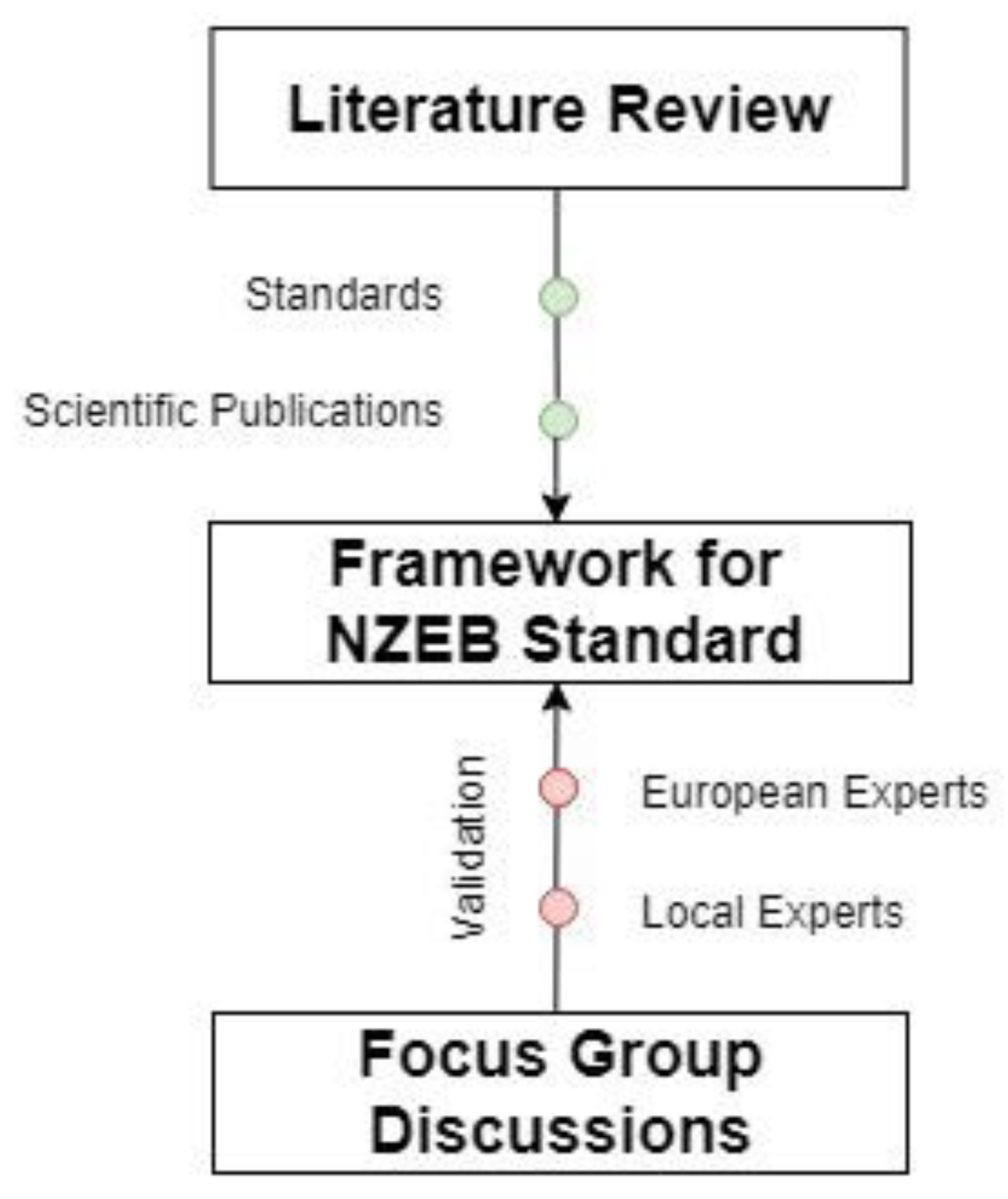
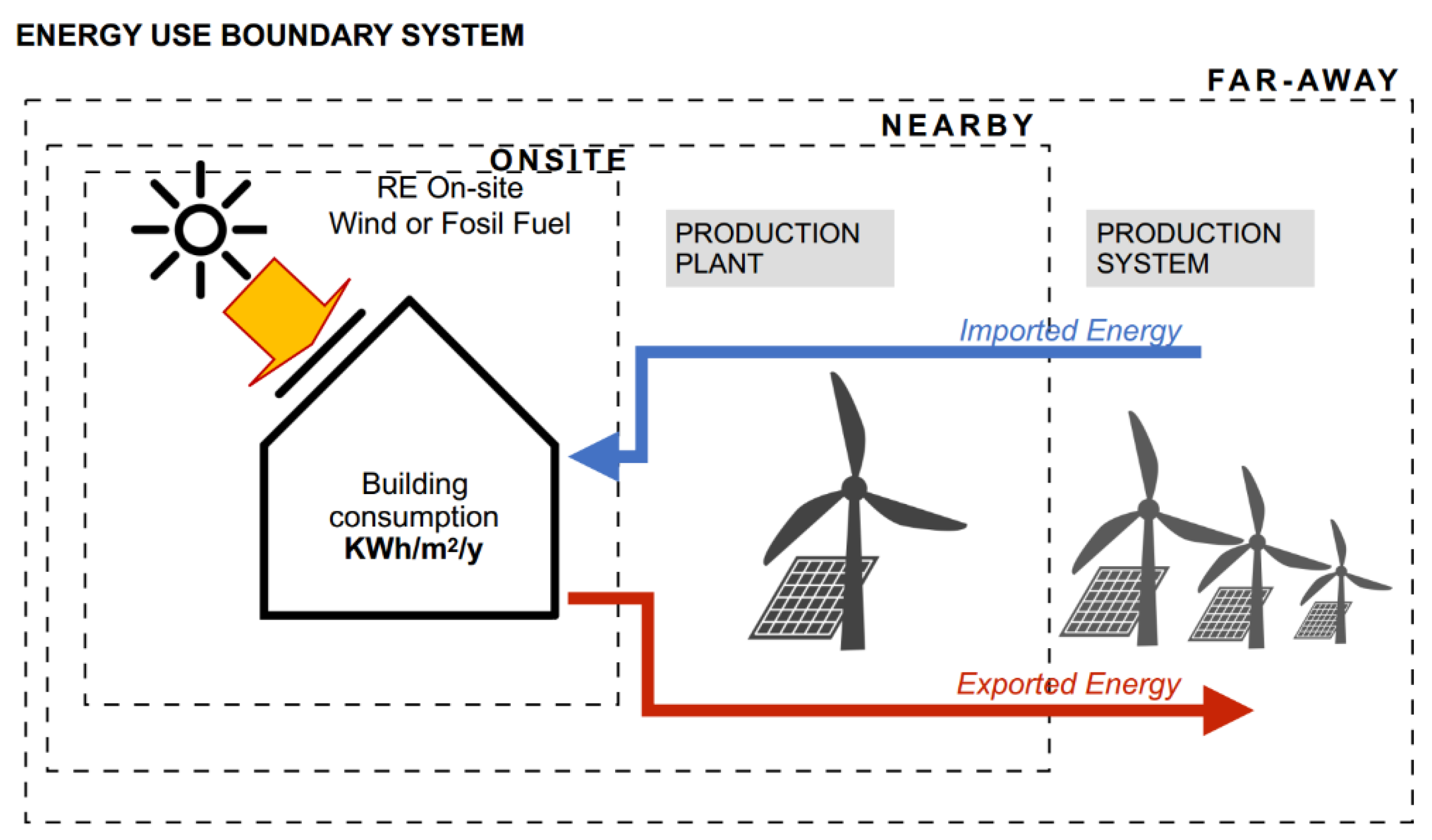
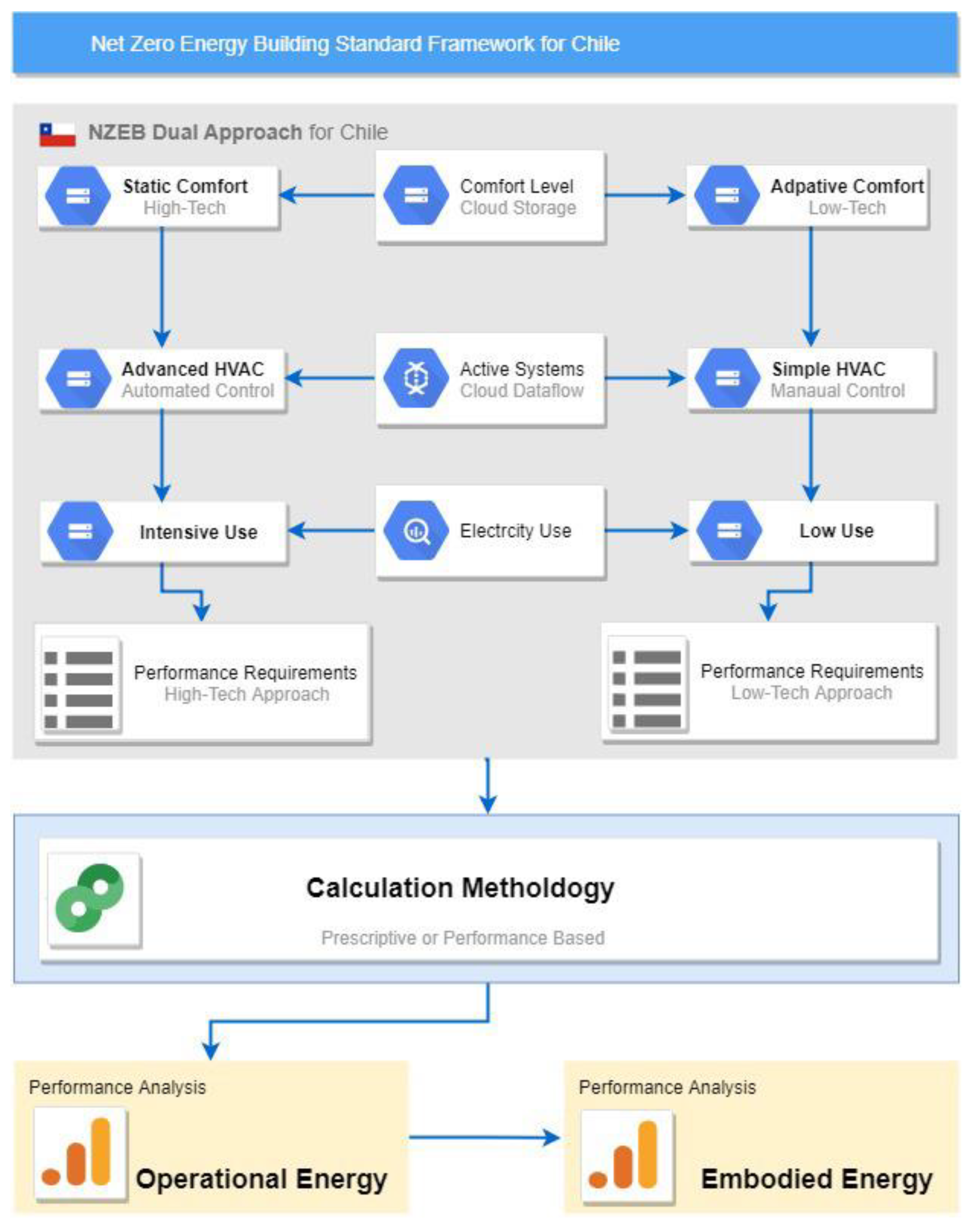
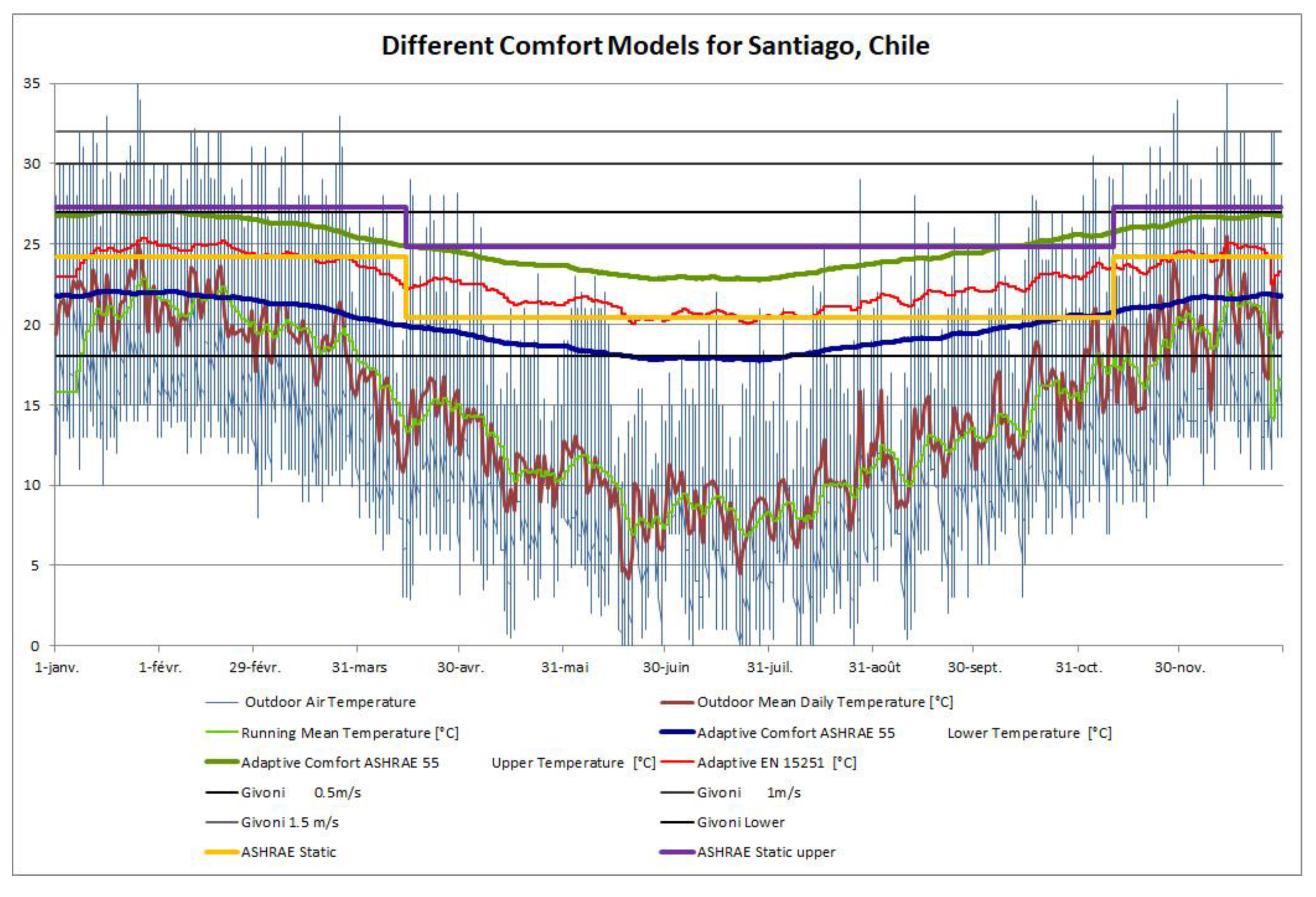
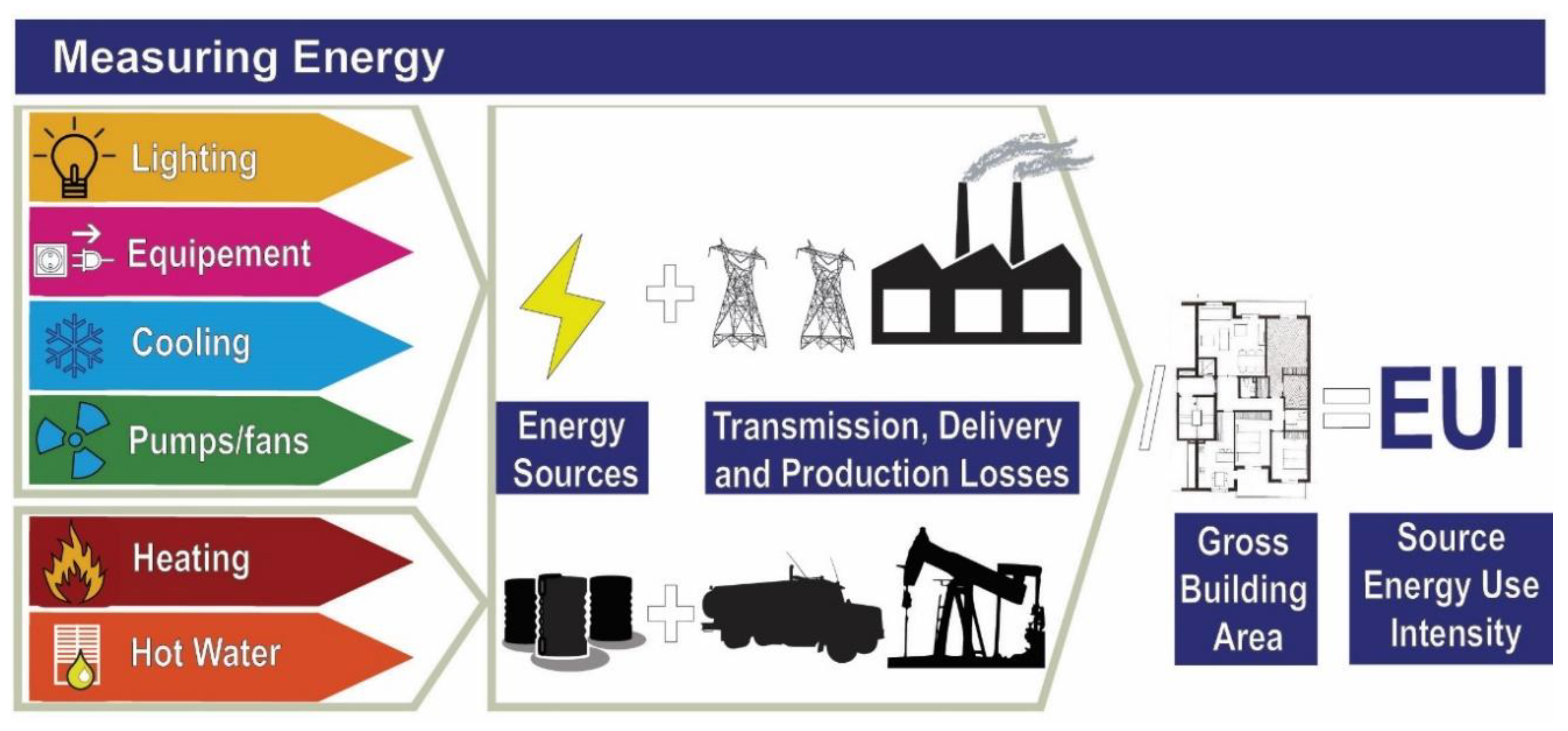
| Country | Non-Residential Buildings (kWh/m2/Year) | Notes | |
|---|---|---|---|
| New | Existing | ||
| Sweden | 30–105 | ND | Depending on the building type and climate |
| Spain | 45–60 | 120 | The proposed indicators aim to define maximum net PE use, maximum total PE use and minimum renewable contribution. |
| Romania | 50–102 | 120–400 | Depending on the building type and climate |
| France | 70–110 | ND | Depending on the climate |
| Denmark | 25 | 25 | Included: Heating, cooling, ventilation, DHW, lighting |
| Bulgaria | 40–60 | 40–60 | - |
| Belgium (Brussels) | 90 | 108 | Included: Heating, DHW and appliances |
| Austria | 170 | 250 | from (2021) |
| First NZEB Principle | Second NZEB Principle | Third NZEB Principle | Fourth NZEB Principle |
|---|---|---|---|
| Reduce energy demand | Improve indoor environmental quality | Provide renewable energy share | Reduce primary energy and carbon emissions |
|
|
|
|
| High-Tech Approach | Low-Tech Approach | |
|---|---|---|
| Energy Efficiency Target: | 15–25 kWh/m2y | min. 15–45 kWh/m2y |
| Renewable Energy Target: | 15 kWh/m2y | 30–45 kWh/m2y |
| Envelope: | Max. Insulation and air tightness static and adaptive models | Max. bioclimatic and passive design solutions |
| Thermal Comfort: | Static and adaptive models | Adaptive models |
| Air Quality: | 800 ppm | 1200 ppm |
| Behavior: | Conscious and based on rigid operation schedules | Conscious and adaptive |
| Systems: | Mechanical ventilation with heat recovery, ultra-efficient HVAC systems. | Hybrid ventilation, with individual heating and cooling unit. |
| Controls: | Building Management Systems (BMS) | None or manual |
| Monitoring: | Real-time and full monitoring using smart meters. | Monthly and manual energy consumption readings |
| Operation: | Full time dedicated expert or facility manager | By users |
| Cost: | Cost-Optimality calculation every 5 years coupled to incentives | Cost-Optimality calculation every 5 years coupled to incentives |
© 2019 by the authors. Licensee MDPI, Basel, Switzerland. This article is an open access article distributed under the terms and conditions of the Creative Commons Attribution (CC BY) license (http://creativecommons.org/licenses/by/4.0/).
Share and Cite
Piderit, M.B.; Vivanco, F.; van Moeseke, G.; Attia, S. Net Zero Buildings—A Framework for an Integrated Policy in Chile. Sustainability 2019, 11, 1494. https://doi.org/10.3390/su11051494
Piderit MB, Vivanco F, van Moeseke G, Attia S. Net Zero Buildings—A Framework for an Integrated Policy in Chile. Sustainability. 2019; 11(5):1494. https://doi.org/10.3390/su11051494
Chicago/Turabian StylePiderit, María Beatriz, Franklin Vivanco, Geoffrey van Moeseke, and Shady Attia. 2019. "Net Zero Buildings—A Framework for an Integrated Policy in Chile" Sustainability 11, no. 5: 1494. https://doi.org/10.3390/su11051494
APA StylePiderit, M. B., Vivanco, F., van Moeseke, G., & Attia, S. (2019). Net Zero Buildings—A Framework for an Integrated Policy in Chile. Sustainability, 11(5), 1494. https://doi.org/10.3390/su11051494






